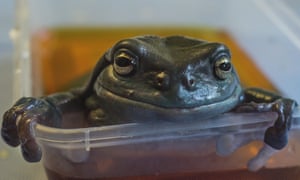The head of Australia’s only dedicated frog hospital believes powerful insecticides are behind a staggering decline in frog populations along the Queensland coast.
But Deborah Pergolotti, of the Cairns Frog Safe project, has struggled to drum up government and academic interest in researching the bizarre malformations she has documented in amphibians.
“The first domino in the sequence is chemicals,” she says, specifically neonicotinoids.
Introduced in Australia in 1996, neonicotinoids attack the nervous system of insects and have caused controversy overseas for their perceived link to declining bee populations.
The European Union has restricted their use, but they are used widely in Australia.
Pergolotti estimates there has been a 95% decline in the Cairns frog population since the hospital opened 17 years ago.
“The usual comment is: ‘What proof do you have?’ ” she said.
“If somebody would get around to doing the toxicology for it, then maybe we might get some proof, but nobody’s interested in the toxicology.”

Pergolotti has treated frogs with extra limbs, missing eyes, cancer, stunted growth and skeletal problems, none of which occurred before 1996, she said.
But her attempts to alert authorities have fallen on deaf ears.
A 2014 report by the Australian Pesticides and Veterinary Medicines Authority, prompted by concerns for bee populations, found there was a “lack of consensus” on the causes of regional declines.
Ultimately, “multiple interacting pressures” were to blame, it said.
Pergolotti called for an overhaul of the way farming chemicals are approved in Australia. She said the process was “barely higher than a rubber stamp”.
The authority’s Dr Matthew O’Mullane said any impacts on frogs were considered as part of the vertebrate aquatic risk assessment and risks were covered by “more general statements” on product labels.
“If new information became available to indicate that frogs were specifically affected by neonicotinoids then the [authority] would consider the scientific merits of the new information and whether product labels needed to be changed to mitigate risks,” he said.
The federal environment department said experts involved in a coming review of the conservation status of frogs had not raised any issues relating to the insecticides.
Meanwhile, a spokeswoman for Queensland’s Department of Environment and Heritage Protection said it had no direct control over the insecticides and was not aware of any recent studies on their potential harm to frogs, nor declining frog populations.
https://www.theguardian.com/environment/2016/jul/04/pesticide-blamed-for-huge-drop-in-frog-numbers-along-queensland-coast
